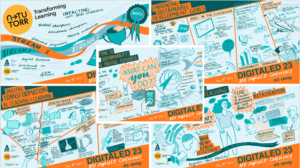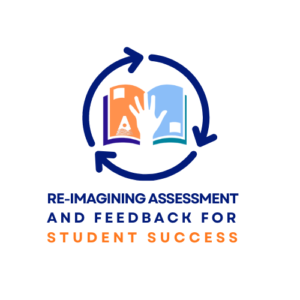Advice from Sean Michael Morris
@slamteacher
https://www.seanmichaelmorris.com
Online doesn’t mean you need to change how you teach. You are still just as human, and so are the students on the other side of your screen. Email, text messages, phone calls—these are all ways to sustain a human connection.
Be honest about what this transition means for you and for students. The rest of the academic year will not be the same. You will need to improvise and be patient. Students will need to improvise and be patient.
Rethink grading. Normal rules of rigour, attendance, participation need to be revisited. Asynchronous work is harder than synchronous work (most people find working remotely difficult). Assessment should reflect that.
Human connection will always work better than technological connection. Don’t rely on tools as a substitute for what you already do well. Edtech doesn’t teach, you do.
Look for simple solutions. Don’t complicate distant learning suddenly with unnecessary tools or expectations. Use reliable, familiar tools (email, text messages, Moodle, etc.) so that teaching can remain the core of your work.
Be responsive. Many students may not have internet access at home. They may not have computers at home. Find out what they need, what they can do, and work with them. This means more work for you, but it’s the only way to be equitable.
Be sure that any digital tools you use are mobile-friendly. More students will have access to mobile phones than they will computers. Ensuring that students have points of entry, no matter their hardware limitations, is necessary.
Everyone in this situation will make mistakes. Be okay with that. Digital learning and digital pedagogy are tricky for even the most proficient online teachers. Forgive and be forgiving.
If you need help, reach out. There is an enormous community of digital educators on Twitter, and they will help. Use #digped to find support.
Advice from Professor Martin Weller (Open University, UK)
Martin Weller is the director of The Open Education Research Hub and the director of the GO-GN network.
- Activities that can be done quickly face to face take much more time online, particularly collaborative activities.
- In discussion forums you may find that people who don’t speak up in class, have more to say.
- Things you think are obvious, won’t be. If something can be misinterpreted, it will be. So if you can run things by critical readers, do so. If not, add in layers of explanation and be ready to clarify.
- Related – once a mistaken belief takes hold, it is very difficult to rectify, much more so than face to face, so get on top of it quickly.
- A distant, aloof air in classroom may be acceptable, but seems even more cold and remote online. Be friendly!
- Structure different types of activity and engagement. “Read this for two hours and then watch this for an hour” is hard going.
- Encourage peer to peer interaction, but you will need to monitor this if in public forums. Things can flare up quickly online.
- Don’t try to just replicate the lecture course (if you have time), think about what the new medium affords you – asynchronous discussion, different resources you can draw upon, a range of tools, etc.
- When this immediate crisis is over, take time to reflect on how, given longer you might change your pedagogy.
Here are the non-technical challenges your students will experience while switching to online learning:
- Schedule: F2F classes have a schedule, a routine. Online students don’t. If you switch to asynchronous work, students will have to create their routine and stick to it. It is a good idea to overestimate the amount of time that it will take to complete work for you and for them.
- Murphy is a constant companion in online classes: Trying to submit their work at 11:55 pm for an assignment due at midnight? Guess what: the server becomes sluggish, the router dies, things don’t get saved…
- Isolation: Students feel alone. As a teacher, it is a good idea to create an online community for your students. Encourage them to connect with each other. This is a big retention factor btw.
- Instructor presence: An online teacher does not seem to exist, unless they take special effort. Connect with your students, often, and share who you are.. Find a way to keep in touch with your students. I use Slack and keep in touch. I contact my students when they are not understanding a concept (HW). I set up meetings to go over things with them virtually. Make sure to respond to each student, by name, to their asynchronous posts.
- Being proactive: Online teachers can’t see glazed looks on their students’ faces. As a result, teachers need to find other ways to assess the students’ learning. Anonymous polls work well, as they allow students to tell you without shame.
- Doing something fun to help alleviate the stress of the transition: Create a game, be goofy if you can… Students are just as stressed or more than you.
- Technology: Just because your students grew up with technology, does not mean they know how to learn using technology. Videos, pointers, reminders will help. Remember they may be too embarrassed to contact you and say: “I don’t know how to start”.
- Boredom: staying in front of a screen can be difficult and boring for students. Use (open) images to catch students’ attention and surprise them as frequently as possible. Art is a strong ally when it comes to perspectives on a concept, or an inspiration before an explanation. Show artworks and ask students to tell you what they see, then bring them to the concept you want them to focus on and explain it. They will find it easier to listen and share their views. For example, take Shigeo Fukuda sculptures and the role of light and its position, in order to give meaning through a shadow.
- Support them while getting organized: being that it is not easy to focus when many distractions can fill the scenario your students are in, give them tips, starting from what can make them more comfortable. You might suggest something like choose the right location (not too noisy, not too enlightened, not too full of movements, not too chatty friends…), have water and fruit handy, stretch from time to time. Their mind will focus more effectively if their body is comfortable enough.
Source:
https://lta.hw.ac.uk/supporting-student-learning-online/










